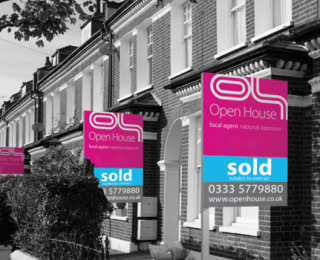How effective are ‘For Sale’ Boards and Estate Agent websites?
In this series of blogs we’re looking at different marketing tools used by estate agents and asking which ones work best and whether clients are getting value for money.
Estate Agents’ websites
Estate Agents sometimes try to dazzle prospective customers with website statistics and how listing properties for sale with them can make all the difference. Whilst it’s true that estate agents’ websites can generate a certain amount of interest, normally this is insignificant compared to listings on dominant national property portals like Rightmove.
Some large corporate agents’ websites might well achieve higher search engine rankings than small local operators, but traffic volume may not always be matched by the quality of any resulting enquiries.
Home movies
Property listings for more upmarket homes often include virtual tours. This trend became more important during Covid lockdowns when physical viewings were effectively rationed.
From the seller’s point of view a video trek through their home can weed out nosy-parkers and time-wasters who might otherwise be chronically dismayed by your taste in decor.
Having seen the video, everyone who subsequently decides to physically view the property should already know what to expect. Hence they are more likely to be serious buyers.
On the other hand, there is always the risk that showing too much too soon can actually put people off.
For Sale boards
Sale boards were traditionally regarded as one of the agent’s most effective marketing tools, generating as much as a third of enquiries in some areas. But today they are probably more effective at tipping off your neighbours that you’re planning to move out (possibly because of them!)
Agents are extremely keen on boards because they are a form of free advertising. Like shop windows, they help promote their brand and attract fresh sellers.
Indeed, one measure of success in a local area was traditionally the ‘board count’. Those with the most boards around town would shamelessly boast of percentage market share – but this is an easy statistic to manipulate.
The general idea is to leave the boards erected for as long as possible, ideally displaying the word ‘SOLD’.
To attract viewers who don’t routinely check the internet, sale boards can potentially be a useful device. However the jury is still out on whether there is any merit in the claim that properties with signs outside sell quicker than those without. That said, it’s surprising how many people notice them.
They can also be helpful for people going on viewings in remote rural areas trying to find ‘The Old Cottage’ – or conversely on busy roads where it helps to know where you’re heading without having the ‘kerb crawl’ and squint at semi-obscured house names and numbers.
Under existing planning and advertising regulations, agents are allowed to place boards on a building or land that is for sale, but signs erected elsewhere require special permission.
Needless to say, some rogue estate agents ignore this and regularly erect signs on the sides of blocks of flats, in communal gardens, in car parks, or public lavatories. More reputable firms earn the right to display their boards as a quid pro quo for sponsoring village fetes and local events.
Contravention of the regulations is a criminal offence under the Town and Country Planning Act. In addition, the maximum size for a single board at 0.5m2, or a slightly larger 0.6m2 where two signs are joined together.
Our next blog – coming soon ……
What do estate agents actually do?
Check out our Rightsurvey blog page for more industry tips and secrets written by property professionals to help put you in control.



